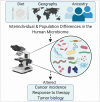An overview of cancer health disparities: new approaches and insights and why they matter
- PMID: 33185680
- PMCID: PMC7717137
- DOI: 10.1093/carcin/bgaa121
An overview of cancer health disparities: new approaches and insights and why they matter
Abstract
Cancer health disparities remain stubbornly entrenched in the US health care system. The Affordable Care Act was legislation to target these disparities in health outcomes. Expanded access to health care, reduction in tobacco use, uptake of other preventive measures and cancer screening, and improved cancer therapies greatly reduced cancer mortality among women and men and underserved communities in this country. Yet, disparities in cancer outcomes remain. Underserved populations continue to experience an excessive cancer burden. This burden is largely explained by health care disparities, lifestyle factors, cultural barriers, and disparate exposures to carcinogens and pathogens, as exemplified by the COVID-19 epidemic. However, research also shows that comorbidities, social stress, ancestral and immunobiological factors, and the microbiome, may contribute to health disparities in cancer risk and survival. Recent studies revealed that comorbid conditions can induce an adverse tumor biology, leading to a more aggressive disease and decreased patient survival. In this review, we will discuss unanswered questions and new opportunities in cancer health disparity research related to comorbid chronic diseases, stress signaling, the immune response, and the microbiome, and what contribution these factors may have as causes of cancer health disparities.
Published by Oxford University Press 2020.
Figures



Similar articles
-
Analysis of Tumor Biology to Advance Cancer Health Disparity Research.Am J Pathol. 2018 Feb;188(2):304-316. doi: 10.1016/j.ajpath.2017.06.019. Epub 2017 Nov 11. Am J Pathol. 2018. PMID: 29137948 Free PMC article. Review.
-
Immune response and inflammation in cancer health disparities.Trends Cancer. 2022 Apr;8(4):316-327. doi: 10.1016/j.trecan.2021.11.010. Epub 2021 Dec 27. Trends Cancer. 2022. PMID: 34965905 Free PMC article. Review.
-
The Disproportionate Impact of COVID-19 on Racial and Ethnic Minorities in the United States.Clin Infect Dis. 2021 Feb 16;72(4):703-706. doi: 10.1093/cid/ciaa815. Clin Infect Dis. 2021. PMID: 32562416 Free PMC article.
-
COVID-19 Pandemic: Disparate Health Impact on the Hispanic/Latinx Population in the United States.J Infect Dis. 2020 Oct 13;222(10):1592-1595. doi: 10.1093/infdis/jiaa474. J Infect Dis. 2020. PMID: 32729903 Free PMC article.
-
Rural Cancer Screening and Faith Community Nursing in the Era of the Affordable Care Act.J Health Care Poor Underserved. 2018;29(1):71-80. doi: 10.1353/hpu.2018.0008. J Health Care Poor Underserved. 2018. PMID: 29503289
Cited by
-
Gerotherapeutics: aging mechanism-based pharmaceutical and behavioral interventions to reduce cancer racial and ethnic disparities.J Natl Cancer Inst. 2025 Mar 1;117(3):406-422. doi: 10.1093/jnci/djae211. J Natl Cancer Inst. 2025. PMID: 39196709 Review.
-
Social Support Buffers the Effect of Social Deprivation on Comorbidity Burden in Adults with Cancer.Ann Behav Med. 2024 Oct 16;58(10):701-706. doi: 10.1093/abm/kaae035. Ann Behav Med. 2024. PMID: 38935875 Free PMC article.
-
Association of Neighborhood Deprivation With Prostate Cancer and Immune Markers in African American and European American Men.JAMA Netw Open. 2023 Jan 3;6(1):e2251745. doi: 10.1001/jamanetworkopen.2022.51745. JAMA Netw Open. 2023. PMID: 36662526 Free PMC article.
-
An intersectional analysis of behavioral financial hardship and healthcare utilization among lesbian, gay, bisexual, transgender, queer, plus cancer survivors.J Natl Cancer Inst. 2025 May 1;117(5):997-1007. doi: 10.1093/jnci/djae350. J Natl Cancer Inst. 2025. PMID: 39745895
-
Simultaneous triple primary malignancies, including bladder cancer, lymphoma, and lung cancer, in an elderly male: A case report.Open Life Sci. 2022 Sep 26;17(1):1263-1268. doi: 10.1515/biol-2022-0500. eCollection 2022. Open Life Sci. 2022. PMID: 36249529 Free PMC article.
References
-
- Siegel, R.L. et al. (2020) Cancer statistics, 2020. CA Cancer J. Clin., 70, 7–30. - PubMed
-
- Singh, G.K. et al. (2014) Widening rural-urban disparities in life expectancy, U.S., 1969–2009. Am. J. Prev. Med., 46, e19–e29. - PubMed
-
- Jemal, A. et al. (2008) Mortality from leading causes by education and race in the United States, 2001. Am. J. Prev. Med., 34, 1–8. - PubMed
Publication types
MeSH terms
LinkOut - more resources
Full Text Sources
Medical

